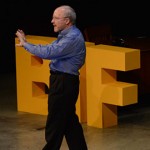Oct20
Make Your Product a Narrative — #BIF7
Point: Technology and innovation enable greater customer engagement through open-ended customizations, apps, add-on, and social features.
Story: At BIF7, John Hagel, author of The Power of Pull, highlighted what he saw as a distinction between story vs. narrative.  A story is complete, self-contained, and has a beginning, middle, and end. Stories have audiences: people who passively consume the story. In contrast, Hagel defined a “narrative” as an open-ended, unfolding sequence that continues into the future. Narratives frame the world and the people in it. Under this definition, narratives create participants: active co-creators in the evolving timeline of current and future events. Whether you agree or disagree with Hagel’s particular choice of words, the key is in the interesting distinction between a closed-ended tale and an open-ended dialogue — and what that distinction means for product innovation..
A story is complete, self-contained, and has a beginning, middle, and end. Stories have audiences: people who passively consume the story. In contrast, Hagel defined a “narrative” as an open-ended, unfolding sequence that continues into the future. Narratives frame the world and the people in it. Under this definition, narratives create participants: active co-creators in the evolving timeline of current and future events. Whether you agree or disagree with Hagel’s particular choice of words, the key is in the interesting distinction between a closed-ended tale and an open-ended dialogue — and what that distinction means for product innovation..
Although Hagel didn’t say so directly, the concept of story v. narrative can be applied to product innovation: some products are like stories and some are like narratives. Some products are meant to simply be bought and consumed, like the beginning-middle-end of a story. It’s a “once upon a time, someone used the product and they lived happily ever after” story.
In contrast, other products are like narratives, in which purchasing the product is just the start of a long series of interactions with that product, with related products, and even with other people. Such products let people customize, individualize, and enhance the product. Customers can tap into an ecosystem of add-ons, apps, tracking, feedback, and engagement. Customers can interact with other customers or with the company’s services for on-going enhancements. In short, the customer joins the narrative and extends it, too..
The most obvious example of the narrative-style product is the Apple iPhone, with its “there’s an app for that” opportunities for customization and engagement. Similarly, Nike converted a consumer good — shoes — into narrative-driven product with strong participant engagement through Nike+. A sensor in the shoe and wireless connection to an iPhone, iPod, or special watch lets users of its shoes track their exercise. People can then share their runs with others, participate in virtual races, and learn about great running routes from others..
Technology enables more and more of these kinds of narrative products. Companies can now leverage low cost or existing electronics (e.g., smartphones), low-cost software, and low-cost web/cloud services to create an ongoing customizable social experience. Companies can also use existing social platforms (like FourSquare, Twitter, Facebook, etc.) to create a narrative environment for their product or service.
Action:
- Is your product like a closed-ended tale or can you make it like an open-ended dialogue with your customers?
- Create a brand to encompasses the customer (vs. simply defining the product or the company)
- Create optional tracking or feedback that lets customers record their piece of the narrative.
- Create optional add-ons or apps that support customization or ongoing enhancements.
- Create an ecosystem of partners and encourage open innovation around a narrative product platform.
- Create social engagement that lets customers not just use the product but also interact with the people behind the product and the other users of the product.
Comments Off on Make Your Product a Narrative — #BIF7Customers, Innovation, New Product Development, Social Media









